Pak Invasion - Looking Back
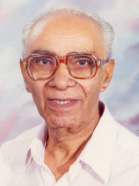 Sh. Sati Sahni is a Veteran Journalist
with an experience of over six decades in the profession. An ace
photographer, he is the only working Journalist to have covered all the
four wars--1947-1948, 1962,1965 and 1971. In a conversation with
Kashmir
Sentinel he visited down memorylane to recapture his experiences in
covering Pak Invasion in 1947-48. The first part of the conversation was
carried in previous issue, Nov. 2007. The second part is being published in
this issue.
- The
Editor Sh. Sati Sahni is a Veteran Journalist
with an experience of over six decades in the profession. An ace
photographer, he is the only working Journalist to have covered all the
four wars--1947-1948, 1962,1965 and 1971. In a conversation with
Kashmir
Sentinel he visited down memorylane to recapture his experiences in
covering Pak Invasion in 1947-48. The first part of the conversation was
carried in previous issue, Nov. 2007. The second part is being published in
this issue.
- The
Editor |
KS: You covered the
1947-48 war as a correspondent. Did you represent any paper then?
SS:
At the time of war I was not a working
journalist. My interest was definitely in the profession. Since I knew senior
officers in Maharaja's administration and also the top leaders of political
parties, particularly National Conference I had access to all news yielding
sources.
On 27th of October, 1947
the day first batch of Indian troops landed in Srinagar a clutch of reporters
from Delhi were flown by an Army PRO. They included M.Sobhan, younger brother of
Brig. Usman and a reporter each from The Hindu and the API
(later renamed as PTI). Sobhan came as representative of The Times of
India and Indian News Chronicle group. It was sheer chance that I
happened to meet these reporters the same evening and remained associated with
them during the next three days they were in Srinagar. I helped them in news
gathering and arranged their meetings with NC leaders.
Before returning to Delhi
M.Sobhan asked me if I would be available to send the reports on the ongoing
war from Srinagar to The Times Of
India;
I readily agreed. This was the start of my
active journalistic profession. My career thus began as a war correspondent. It
is a rare occasion in the journalism profession. Covering war for a novice is a
difficult job in view of inexperience, unfamiliarity with war terminology etc.
It also involves high-voltage reporting.
On 30th October three
foreign correspondents were also flown to Srinagar. The battle of Baramulla was
going on. The first reports on the war were sent by Sobhan and other
journalists.
KS: What were your
initial experiences in covering the war?
SS:
The Emergency administration took over on 31st of October. Its operational
office was set-up in Palladium Talkies in Lal Chowk, while the formal offices
were in Old Secretariat.
For the first two nights
the Army troops and the IAF staff which landed in Srinagar had to stay in tents
at the Airstrip. The senior officers were later lodged in the State Guest House,
opposite Amar Singh Club. A visit to the State Guest House and 2-3 visits to
Palladium Talkies were required every day to get the latest information of
happenings around. There was no formal Information Department nor any Defence
PRO stationed in Srinagar. The correspondents covering the operations had to be
on their own, secure whatever information they could and then use it on their
own responsibility. There were other difficulties as well. One could not go to
theatre of operations. There were no arrangements, no transport, no
communication facilities etc. It was difficult to verify the news since there
was no official briefing. Lot of rumours were making rounds in Srinagar city.
For first 5-6 days we were bottled up in the city.
KS: Who were the
correspondents who covered the war then?
SS:
We were only two journalists-Pt. Radha Krishan Kak and myself. Sh. Nand Lal
Wattal used to visit Palladium Talkies once or twice a day to meet NC leaders
but he did not cover war as such.
KS: There was an
ugly episode in which there was accidental killing of some civilians in Srinagar
by army soldiers? What was that?
SS:
This episode took place on 2nd of November. Lal Chowk was agog with reports that
army personnel had killed some civilians somewhere between airstrip and Rambagh.
In Lal Chowk we learnt that a 2000 strong procession carrying dead bodies of
those killed was proceeding towards Srinagar. It was raising anti-Indian
slogans, blaming the armymen for deaths. There were slogans like 'Katle Aam
Ho Gaya'. When this information reached NC leadership at Palladium Talkies,
Bakshi Gh. Mohd. left in an army truck along with few volunteers. He confronted
the processionists at the Rambagh bridge. Bakshi was able to pacify them by
explaining the circumstances in which the three civilians had got killed. Thus a
major demonstration of communal nature was averted. National Conference was
quick to blame the Muslim Conference workers for instigating the crowd. In
retrospect I shudder to think what situation could have erupted if this
procession had reached Amirakadal or Lal Chowk area. The inflamed sentiments
could have resulted in communal riots, even killings.
This timely handling of
this delicate situation made the authorities aware of the dangers inherent. The
Emergency administration devised strategies to counter such moves. In every
mohalla volunteers were deployed. Situation was very fluid, in fact, critical on
the evening of 2nd November. This was in a way the beginning of the Peace
Brigade. Though it would have taken 8-10 days but the episode of 2nd
November precipitated its constitution. The episode of 2nd November was my first
reporting. Those days the tradition of mentioning byline was not there.
KS: You also
reported on defeat of the Pakistanis/Raiders at Budgam and Shalteng.
SS:
On 2nd of November after Col. Rai had been killed at Baramulla the local
commander decided to pull back to Pattan so that defences of Srinagar could be
strengthened.
In the meantime the enemy
decided to put into action the three-pronged strategy to capture Srinagar. One
column was to move along the main highway to Srinagar, left hook was to send
contingent to Budgam to take care of the Airport and engage the Indians there.
Second one was to try and infiltrate towards Ganderbal. The enemy was able to
reach Budgam Sector on 2nd November.
In the meantime a company
of Kumaonis was landed at Srinagar and rushed to the
Budgam front. Its incharge was Major Somnath Sharma whose hand was in plaster
due to an injury. For the next 30 hours the Kumaonis were able to hold back the
enemy, but on the afternoon of 3rd November a massive attack overwhelmed the
Indian forces. Major Sharma was killed on the spot. He belonged to Himachal
Pradesh. His father had served as Major General of Medical Services. Major Som
Nath Sharma's indomitable courage and high quality of leadership he showed
earned him posthumously the first Paramvir Chakra of the country. He had saved
the Srinagar Airport from falling into the hands of the enemy.
During the next three days
reinforcements came in by road also. This included artillery pieces, armoured
cars and Infantry. The Brigade Headquarters was set up and three different
brigade commanders took charge on three different days. On the first day the
brigade commander was injured, then on the second day another one was brought in
his place. The following day he was promoted and sent to the front. The new
brigade commander took over. On 5th of November Major General Kulwant Singh
landed in Srinagar and took charge as Commander of the forces. It was decided
that before the enemy launched a direct offensive against Srinagar from areas
around Shalteng, where they had amassed a large force, should be confronted on
its hometurf. Offensive was considered to be best defence in these
circumstances. In the meantime air support had also become available. Fighters
from Ambala and Amritsar had successfully landed in Srinagar and were available.
Armoured cars, heavy
artillery and air support were used first time in Kashmir at Shalteng. The operational Brigade was under the Command of Brig. LP
Sen, with overall responsibility being that of Major General Kulwant Singh. The
Western Command was headed by Lt. General KM Cariappa.
The strategy had been so
well worked and tactics properly honed that within seven hours the battle of
Shalteng ended in large-scale death of enemy personnel and a total rout of their
massive concentration. By evening our troops had pursued them to Pattan. The
enemy lost hundreds of their personnel and equipment. Some managed to reach
Baramulla, others continued their journey towards Uri. Shalteng proved to be the
Waterloo of Pakistani attempted invasion. This was on 7th November. We did not
go to the front because there was no transport, no direction nor any permission
from the authorities. For news gathering our link in Guest House was Lt. Col.
Harbaksh Singh, the Station Commander. He would do daily briefing. Col. PN Kak
came 2 months later.
KS: How was
Baramulla retaken from the enemy? What had been the fate of the town under its
occupation by Pakistanis?
SS:
On 8th of November after regrouping, the thrust to Baramulla continued and
Indian forces entered the town on the same day in late hours.
On 9th November the army
took Bakshi Ghulam Mohammad, senior NC leader and Emergency Officer (Home) to
Baramulla to show him the destruction wrought by Raiders and also facilitate his
meeting with survivors. We--myself and Pt. RK Kak accompanied Bakshi Sahib, an
army one-tonner carried us to the town. We reached Baramulla around noon. Brig.
Sen was already there.
What we witnessed in
Baramulla was a scene of death, destruction and desolation. Smoke was still
billowing from some of the buildings which had been abandoned by the enemy and
set on fire before they escaped from Baramulla. Bakshi Sahib was informed that
out of 14 thousand odd population less than 2 thousand were in Baramulla on that
day i.e. on 9th of November. The rest had either been killed or had left
Baramulla for safer places. Bakshi Ghulam Mohammad was also shown the place
where Maqbool Sherwani was killed. He was taken to St. Joseph
Hospital, where he met the surviving nuns. He was shown the fresh graves of the
foreigners and one Indian doctor and a nurse who had been killed by the enemy.
Later, he visited the interiors of the town where he heard heart-rending stories
from the survivors about the atrocities committed by the enemy troops and the
looting and destruction by them. Bakshi Sahib was also told that nearly 300
truck loads of booty of the loot was sent out of Baramulla towards Domel the
previous day. The people related stories of rapes and killings. The Pashtun
tribesmen had no regard for anyone. We were told in Baramulla of Ch. Faizullah's
role in facilitating the Pakistani invasion and assisting their commanders in
Baramulla. Bakshi Ghulam Mohammad was informed that the refugees considered him
a Pakistani officer rather than Wazir Wazarat of Baramulla. I had met Ch.
Faizullah in Srinagar 10-15 days before
the invasion. Faizullah had left along with convoy of loot. Bakshi felt very sad
after visiting Baramulla.
In the meantime Indian
troops continued the thrust towards Uri which was liberated on 11th of November.
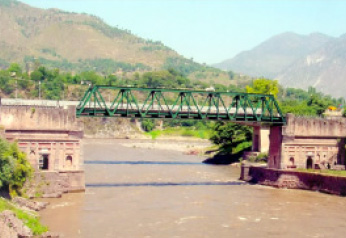
The Historic Domel Bridge.
KS: Did you send
your despatches directly to your editorial office?
SS:
There were only two of us - Sh. RK Kak and Myself who were covering the war. We
had to file reports and hand them over to a designated Army officer. He would
then send these through Army signals to the Defence Ministry. After scrutiny the
reports were passed on to the respective newspaper offices for publication.
Sometimes the report sent by us would be published after two days, because there
was low priority for it as against operational reports.
KS: Pandit Nehru
also visited Kashmir soon after the liberation of Baramulla town.
SS:
On 11th of November the Prime Minister of India Pt. Jawahar Lal Nehru came to
Srinagar first time after the Pakistani invasion. From the Airport he was
brought to Lal chowk where he addressed a public gathering. Despite the fact
that there was no prior announcement about his public address, yet the whole of
Lal Chowk was full to listen to him. I was present and covered the event.
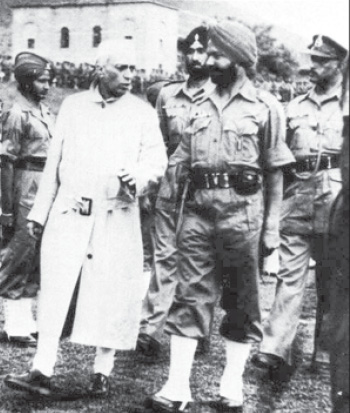
Pt. Nehru during his
Kashmir visit in 1947. On his right is General Kulwant Singh.
Pt. Nehru in his address
assured the people of Kashmir that all possible help would be rendered to defend
them against Pakistan invaders, restore
peace and ensure regular supply of essential items even if it meant lifting
these by air.
Kashmiris felt happy that
the Chief Executive of India had come to support and help. On this occasion Pt.
Nehru assured Sheikh Abdullah of total support in meeting the challenges that
his Administration faced. Sheikh Abdullah in return committed himself to restore
peace in this part of the country and maintain communal harmony and orderly life
for the common man.
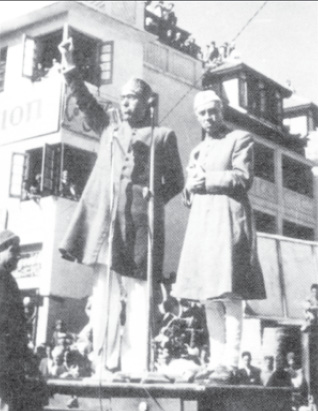
Pt. Nehru making his
historic public address at Palladium, Lal Chowk, Srinagar. On his left is Sheikh
Mohd. Abdullah, The Head of Emergency Administration.
On 12th of November
Nehruji visit Baramulla town. He was accompanied by Sheikh Abdullah, Bakshi Gh.
Mohammd and General Kulwant Singh Pt. Nehru went to the town by road. There was
no airstrip at Baramulla nor there were any helicopters. Besides 2-3 journalists
(one from API) I and RK Kak went to Baramulla with the Prime Minister. We were
not present all the time Nehruji was in Baramulla. He went round the destroyed
and desolate town, saw burnt buildings, and talked to some of the wailing
survivors. Later, he visited St. Joseph
Hospital and Church as well. We were not able to talk to Nehruji in Baramulla.
KS: You did not talk
to Pt. Nehru during this visit?
SS:
He spoke to us in Srinagar the same day after
return from Baramulla. He expressed his anguish at what he had seen and
condemned the violence and the killings perpetrated by Pak army personnel. Pt.
Nehru expressed sympathy with the victims and other survivors. He assured all
help in rushing relief to the affected areas and early rehabilitation in safe
regions. He said he had discussed the resettlement of large number of people who
had managed to escape from areas now occupied by Pak armed raiders. He returned
to Delhi the next day and action was taken without further loss of time on
promises that he made in Srinagar. In the meantime situation in Srinagar had
stabilised. Some semblance of administrative set-up had been restored. Peace and
order prevailed. In the city there was absence of communal tension.
KS: On 15th of
November JAK Force Hqs. was shifted to Jammu under the Command of Major-General
Kulwant Singh. Why was it so?
SS:
Situation was worsening in Jammu region. Since September 1947 Pakistan had been
making raids into Maharaja's territory. These were by armed men who belonged to
Sudhan community of Poonch-Bagh area. Most of them had served in the British
Indian Army. These armed men were directed and guided by Pak army officers. The
latter provided them material support. This kept engaged the State Forces
detachments stationed at different locations on the border.
The intensity of the raids
alongwith their frequency and volume increased gradually. After the regular
attack on 22nd of October it became an almost open rebellion with local hostile
elements joining them. This created problems of law and order and security,
especially for the minorities both in rural areas and urban settlements. The
areas affected included Bhimbar, Kotli, Bagh, Mirpur etc.
KS: Rajouri's fate
was worse. How was this town retaken?
SS:
Reports came in that Pakistanis had overrun
Rajouri on 10th of November and massacred large number of non-Muslims besides
looting the town.
On 16th November a column
under Brig. Paranjpe was sent out to reinforce the garrisons in Nowshera and
Jhangar. In the meantime enemy had amassed a sizeable force southwest of Mirpur
and was preparing for an attack. The relieving column from Jammu could not
proceed beyond Nowshera. The State forces stationed in Mirpur alongwith
thousands of refugees managed to break the Pakistani stranglehold and escaped
towards Jammu.
On 24/25th (November)
night the enemy occupied Mirpur and indulged in large-scale killing and looting.
As our column could not go beyond Nowshera, Kotli could not be relieved.
Meanwhile, 77 Para Brigade had been moved to Jammu area under the command of
Brig. Usman. Soon preparations were made to advance towards the border. For this
it was important that a strong base at Nowshera was built up. Enemy sensing this
made plans to encircle and occupy Nowshera. Pakistanis mounted a major battle in
which nearly 15 thousand men attacked Nowshera from three directions in first
week of February (1948).
The Indian troops fought
back gallantly. At the end of the battle over 2 thousand Pakistanis were killed.
The Battle of Nowshera was the biggest battle in that winter in Jammu region.
Pakistanis had used a mixed force-regular armymen and Pashtun raiders in the
battle, with the command being in the hands of Pak army officers.
In the meantime the enemy
had occupied Jhangar a vital road junction giving access to Kotli and Bhimber.
So the Indian side began making preparations for liberation of Jhangar.
The Army Hqs had decided
that Jhangar may be held at any cost because of its locational importance. The
Brigade Commander, Brigadier Usman was asked by the Army Commander to
concentrate on Jhangar and make efforts to push the enemy as far as possible.
After the plans had been
approved, in middle of March Indian troops launched a two-pronged attack on
Jhangar. It took them two days to liberate Jhangar, with enemy suffering heavy
casualties. Re-taking of Jhangar also relieved pressure of the enemy on Rajouri.
Indian Army then decided to clear the area of the enemy beyond Rajouri. A strong
force was gathered on the south-eastern end on 8th April. On 13th April the
enemy was thrown out of Rajouri town. The death, destruction and atrocities
committed by the Pakistani occupation forces were reportedly more than what they
perpetrated in Baramulla.
KS: How was Brig.
Usman killed?
SS:
The Pak Army commanders had already put up a
very massive price on
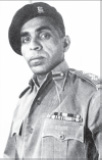 Usman's
head. Repeated efforts were made to eliminate him. Infact, at the time of
partition Pak government offered him promotion of two ranks if he came and
joined Pak army but he refused. Although located in Nowshera Usman had made
frequent trips to Jhangar. On one of his trips while Brigadier Usman was camping
in Jhangar very heavy artillery barrage was directed on the Jhangar Garrison.
While Usman was on the evening of July 2, 1948 moving from bunker to bunker one
sharpnel killed him on the spot. It was a great loss to the Army and the
country. His dead body was flown to Delhi and buried with full state honours. Usman's
head. Repeated efforts were made to eliminate him. Infact, at the time of
partition Pak government offered him promotion of two ranks if he came and
joined Pak army but he refused. Although located in Nowshera Usman had made
frequent trips to Jhangar. On one of his trips while Brigadier Usman was camping
in Jhangar very heavy artillery barrage was directed on the Jhangar Garrison.
While Usman was on the evening of July 2, 1948 moving from bunker to bunker one
sharpnel killed him on the spot. It was a great loss to the Army and the
country. His dead body was flown to Delhi and buried with full state honours.
KS: There was
probably a condolence meeting held in Srinagar at Lal Chowk as well? Did you
have opportunity to meet him?
SS:
Yes there was a condolence meeting in Srinagar
on July 5. I had known Usman because of my association with his brother Subhan.
I had an occasion of meeting him in Jammu in December 1947 and January, 1948. He
was a simple man, a staunch follower of Mahatma Gandhi, a teetotaller,
vegetarian and a votary of Khadi.
Some years ago a film
documentary was made on life and work of Usman. The Army provided all logistics
and a Major General was seconded for all co-ordination work. I was associated
with the making of the film as only living war correspondent who had known and
met him during critical days in 1948.
KS: How was Poonch
liberated?
SS:
In the month of December 1947 the enemy decided to capture Poonch and gathered a
sizeable force to encircle it and force it to capitulate. Meanwhile, a large
segment of minority population out of fear had left their homes and sought
refuge in Poonch town. We were told in Jammu that there were 60-70 thousand
refugees in Poonch town towards the end of December.
The Army Hqs. decided to
break the siege of Poonch and decided to send a relief column from Uri across
Haji Pir Pass. This column after crossing Haji
Pir Pass was nearing a
bridge. Since it was already dusk and from Poonch the march of the column could
be sighted faintly. The defenders of Poonch feared that this was an enemy column
and demolished the bridge. The relief column could not reach Poonch and was
withdrawn back to Uri but a small force on foot under the command of Lt. Col.
Pritam Singh (later Brigadier) was able to reach Poonch. He took command of
whatever forces were there and organized the defences of the town. Col. Pritam
Singh found that besides the population of the Poonch a mass of refugees had to
be taken care of and provided with food and other supplies.
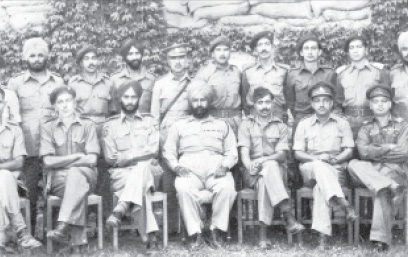
Soldiers of the Poonch
Garrison, June 1948.
Maj. Gen. Kulwant
Singh is seated fourth from right.
Attempts were soon made to
reinforce a defence effort by airdrops. Later, a heroic effort was made to land
an aircraft at the make-shift airstrip. Thereafter inspite of Pakistani
artillery fire the courageous pilots of the RIAF taking advantage of darkness at
night used to land--bringing troops and supplies to the besieged garrison. The
returning planes in a few weeks of time were able to evacuate forty thousand
refugees; a massive effort indeed. Poonch siege continued till middle of June
when for a few days land link from Rajouri could be established. This did not
last long. The enemy after getting reinforcement was able to cut this route
again. Since it was vital to have a land link with Poonch efforts continued to
be made.
Following Brig. Usman's
death the Army Hqs. decided to establish at any cost land link with besieged
Poonch but enemy had under its control some dominating heights in this entire
sector. A number of operations had to be launched to dislodge the enemy from
these heights. Period between April and Sept. 1948 was used to secure passage
for the Indian troops who were charged with the link-up. The final attempt to
link up Poonch with Rajouri started with November 1948, two columns going
through Bhimbar Gali and Mendhar. The main link-up was on 22nd November under
the command of Major General Atma Singh. Poonch had lived under very trying
conditions for one whole year.
In the meantime
considering the importance of operations in J&K Lt. Gen. SM Srinagesh was
appointed as Corps Commander for J&K on 15 September, 1948.
KS: Pt. Nehru also visited Jammu in December
1947.
SS:
In first week of December after the fall of Mirpur it set
Delhi thinking to
takeover entire
Jammu
belt. So Prime Minister Nehru accompanied by Defence Minister flew into Jammu on
4th of December and held a meeting at the Airport to take a final decision. The
military commanders were asked to execute these orders. The meeting was attended
by the Maharaja, Sheikh Mohammad Abdullah, Bakshi Ghulam Mohammad. Major-General
Kulwant Singh, J&K Force Commander gave detailed report about military situation
along the border and likely plans of the enemy.
More: A Conversation with Sati Sahni (click here)
Source: Kashmir
Sentinel
| 